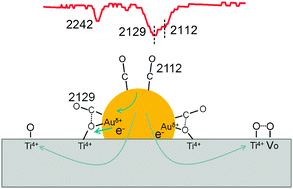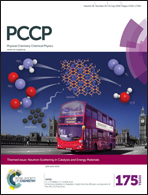Manipulating the charge state of Au clusters on rutile TiO2(110) single crystal surfaces through molecular reactions probed by infrared spectroscopy
Abstract
The charge state of Au clusters deposited on rutile TiO2(110) single crystal surfaces was studied by UHV-FTIRS using CO as a probe. The as-deposited Au clusters on oxidized TiO2(110) surfaces are electrically neutral and are identified by the 2105–2112 cm−1 vibrational frequency of adsorbed CO depending on Au coverage. Annealing Au/TiO2(110) in a moderate O2 atmosphere at 400 K blue shifts the CO vibrational frequency by only 2–3 cm−1 both on bare TiO2(110) surfaces and on Au clusters. However, NO exposure blue shifts the CO vibrational frequency by 16–26 cm−1 for CO adsorbed on Au atoms near the interface and by 3–4 cm−1 for CO adsorbed on top of Au clusters. As the acceptors of the intense charge transfer from Au, the Oa atoms generated through (NO)2 → N2O + Oa reactions on the small fraction of the bare TiO2(110) surface reside around the Au/TiO2(110) interface perimeter, causing the neutral Au0 to be cationic Auδ+ states. This is a new approach to manipulate the charge state of Au clusters on oxide surfaces, which may be helpful in regulating the catalytic redox reactions on oxide supported metal systems.


 Please wait while we load your content...
Please wait while we load your content...